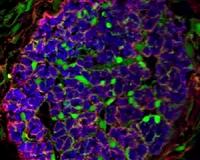 |
Strathclyde, UK (SPX) Nov 16, 2010 A pioneering lighting system that can kill hospital superbugs - including MRSA and C.diff - has been developed by researchers at the University of Strathclyde in Glasgow, Scotland. The technology decontaminates the air and exposed surfaces by bathing them in a narrow spectrum of visible-light wavelengths, known as HINS-light. Clinical trials at Glasgow Royal Infirmary have shown that the HINS-light Environmental Decontamination System provides significantly greater reductions of bacterial pathogens in the hospital environment than can be achieved by cleaning and disinfection alone, providing a huge step forward in hospitals' ability to prevent the spread of infection. This novel decontamination technology was discovered and developed by a multidisciplinary team of experts, Professor Scott MacGregor (Electrical Engineer), Professor John Anderson and Dr Michelle Maclean (Microbiologists) and Professor Gerry Woolsey (Optical Physicist.) Professor Anderson said: "The technology kills pathogens but is harmless to patients and staff, which means for the first time, hospitals can continuously disinfect wards and isolation rooms. "The system works by using a narrow spectrum of visible-light wavelengths to excite molecules contained within bacteria. This in turn produces highly reactive chemical species that are lethal to bacteria such as meticillin-resistant Staphylococcus aureus, or MRSA, and Clostridium difficile, known as C.diff." Dr Maclean added: "The clinical trials have shown that the technology can help prevent the environmental transmission of pathogens and thereby increase patient safety." The technology uses HINS-light which has a violet hue, but the research team have used a combination of LED technologies to produce a warm white lighting system that can be used alongside normal hospital lighting. Professor Scott MacGregor, Dean of the Faculty of Engineering, said: "New approaches to disinfection and sterilisation are urgently needed within the clinical environment, as traditional methods have significant limitations. "Decontamination methods involving gas sterilants or UV-light can be hazardous to staff and patients, while cleaning, disinfection and hand washing, although essential routine procedures, have limited effectiveness and problems with compliance. "HINS-light is a safe treatment that can be easily automated to provide continuous disinfection of wards and other areas of the clinical environment. The pervasive nature of light permits the treatment of air and all visible surfaces, regardless of accessibility, either through direct or reflected exposure to HINS-light within the treated environment." The technology was developed in the University of Strathclyde's pioneering Robertson Trust Laboratory for Electronic Sterilisation Technologies (ROLEST), which is dedicated to controlling infection in today's healthcare environments.
Share This Article With Planet Earth
Related Links University of Strathclyde Farming Today - Suppliers and Technology
 Origin Of Cells Associated With Nerve Repair Discovered
Origin Of Cells Associated With Nerve Repair DiscoveredCambridge, UK (SPX) Nov 16, 2010 Scientists have discovered the origin of a unique type of cell known for its ability to support regeneration in the central nervous system. Their findings, published this week in the journal Proceedings of the National Academy of Sciences USA (PNAS), raise the possibility of obtaining a more reliable source of these cells for use in cell transplantation therapy for spinal cord injuries. Ol ... read more |
|
| The content herein, unless otherwise known to be public domain, are Copyright 1995-2010 - SpaceDaily. AFP and UPI Wire Stories are copyright Agence France-Presse and United Press International. ESA Portal Reports are copyright European Space Agency. All NASA sourced material is public domain. Additional copyrights may apply in whole or part to other bona fide parties. Advertising does not imply endorsement,agreement or approval of any opinions, statements or information provided by SpaceDaily on any Web page published or hosted by SpaceDaily. Privacy Statement |